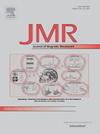Spatially constrained hyperpolarized 13C MRI pharmacokinetic rate constant map estimation using a digital brain phantom and a U-Net
IF 2
3区 化学
Q3 BIOCHEMICAL RESEARCH METHODS
引用次数: 0
Abstract
Fitting rate constants to Hyperpolarized [1-13C]Pyruvate (HP C13) MRI data is a promising approach for quantifying metabolism in vivo. Current methods typically fit each voxel of the dataset using a least-squares objective. With these methods, each voxel is considered independently, and the spatial relationships are not considered during fitting.
In this work, we use a convolutional neural network, a U-Net, with convolutions across the 2D spatial dimensions to estimate pyruvate-to-lactate conversion rate, kPL, maps from dynamic HP C13 datasets. We designed a framework for creating simulated anatomically accurate brain data that matches typical HP C13 characteristics to provide large amounts of data for training with ground truth results. The U-Net is initially trained with the digital phantom data and then further trained with in vivo datasets for regularization.
In simulation where ground-truth kPL maps are available, the U-Net outperforms voxel-wise fitting with and without spatiotemporal denoising, particularly for low SNR data. In vivo data was evaluated qualitatively, as no ground truth is available, and before regularization the U-Net predicted kPL maps appear oversmoothed. After further training with in vivo data, the resulting kPL maps appear more realistic.
This study demonstrates how to use a U-Net to estimate rate constant maps for HP C13 data, including a comprehensive framework for generating a large amount of anatomically realistic simulated data and an approach for regularization. This simulation and architecture provide a foundation that can be built upon in the future for improved performance.

利用数字脑幻影和U-Net估算空间受限超极化13C MRI药代动力学速率常数图。
将速率常数拟合到超极化[1-13C]丙酮酸(HP C13) MRI数据中是一种很有前景的体内代谢量化方法。目前的方法通常使用最小二乘目标来拟合数据集的每个体素。在这些方法中,每个体素都是独立考虑的,在拟合过程中不考虑空间关系。在这项工作中,我们使用卷积神经网络,即U-Net,在二维空间维度上进行卷积,以估计动态HP C13数据集的丙酮酸-乳酸转化率(kPL)图。我们设计了一个框架,用于创建模拟解剖学上准确的大脑数据,该数据与典型的HP C13特征相匹配,为训练提供大量具有真实结果的数据。U-Net最初使用数字幻影数据进行训练,然后使用体内数据集进行进一步训练以进行正则化。在地面真实kPL地图可用的模拟中,U-Net在有无时空去噪的情况下都优于体素拟合,特别是对于低信噪比数据。体内数据进行了定性评估,因为没有真实的基础,并且在正则化之前,U-Net预测的kPL地图显得过于平滑。经过体内数据的进一步训练,得到的kPL图看起来更加真实。本研究演示了如何使用U-Net来估计HP C13数据的速率常数图,包括一个用于生成大量解剖学逼真模拟数据的综合框架和一种正则化方法。这种模拟和体系结构为将来改进性能提供了基础。
本文章由计算机程序翻译,如有差异,请以英文原文为准。
求助全文
约1分钟内获得全文
求助全文
来源期刊
CiteScore
3.80
自引率
13.60%
发文量
150
审稿时长
69 days
期刊介绍:
The Journal of Magnetic Resonance presents original technical and scientific papers in all aspects of magnetic resonance, including nuclear magnetic resonance spectroscopy (NMR) of solids and liquids, electron spin/paramagnetic resonance (EPR), in vivo magnetic resonance imaging (MRI) and spectroscopy (MRS), nuclear quadrupole resonance (NQR) and magnetic resonance phenomena at nearly zero fields or in combination with optics. The Journal''s main aims include deepening the physical principles underlying all these spectroscopies, publishing significant theoretical and experimental results leading to spectral and spatial progress in these areas, and opening new MR-based applications in chemistry, biology and medicine. The Journal also seeks descriptions of novel apparatuses, new experimental protocols, and new procedures of data analysis and interpretation - including computational and quantum-mechanical methods - capable of advancing MR spectroscopy and imaging.

 求助内容:
求助内容: 应助结果提醒方式:
应助结果提醒方式:


